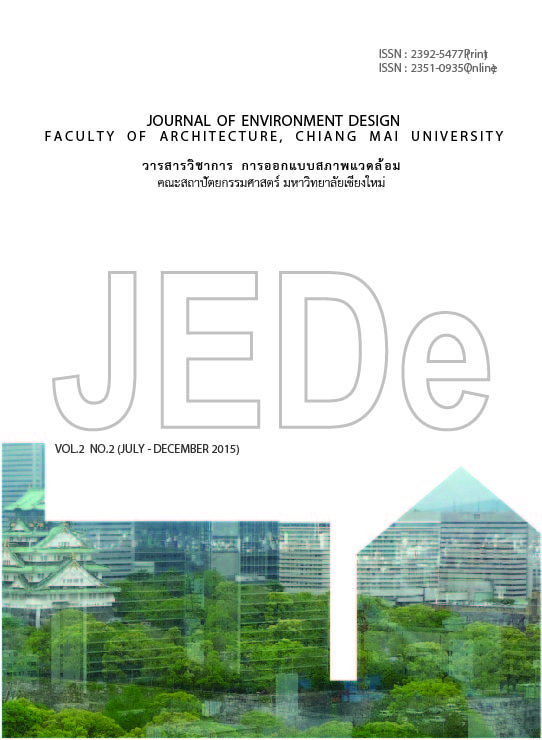คุณลักษณะของที่ว่างทางสถาปัตยกรรมในสถาปัตยกรรมพื้นถิ่น: แนวทางการศึกษาสู่การออกแบบสถาปัตยกรรมร่วมสมัย (Spatial Characteristics in Vernacular Architecture: Approaches to the design of contemporary architecture)
Keywords:
คุณลักษณะที่ว่าง, สถาปัตยกรรมพื้นถิ่น, สถาปัตยกรรมร่วมสมัย, spatial characteristics, vernacular architecture, contemporary architectureAbstract
บทความ “คุณลักษณะของที่ว่างทางสถาปัตยกรรมในสถาปัตยกรรมพื้นถิ่น: แนวทางการศึกษาสู่การออกแบบสถาปัตยกรรมร่วมสมัย” มุ่งศึกษาประเด็นของ “ที่ว่างทางสถาปัตยกรรม” หรือที่เรียกโดยย่อว่า “ที่ว่าง” ประกอบขึ้นด้วย “รูปทรง (Form)” และ “พื้นที่ว่าง (Space)” ซึ่งมีความสัมพันธ์โดยตรงกับ “ปริมาตร (Volume)” ที่เกิดขึ้น เป็นมวลของรูปทรงทางกายภาพกับมวลของพื้นที่ว่างที่ผสมผสานเป็นอันหนึ่งอันเดียวกันอย่างแนบแน่นตลอดเวลา ส่วนของรูปทรง คือ องค์ประกอบทางสถาปัตยกรรมซึ่งเราสามารถมองเห็นและจับต้องได้ ต่างจากส่วนของพื้นที่ว่างที่ค่อนข้างเป็นนามธรรมมากกว่า ส่วนใหญ่การอธิบายถึงที่ว่างทางสถาปัตยกรรมจึงมักกล่าวถึงหรือให้ความสนใจไปในเรื่องของรูปร่าง และรูปทรงเพียงอย่างเดียว จนลืมเลือนความหมายที่แท้จริงของที่ว่างทางสถาปัตยกรรมไป นอกจากคุณลักษณะที่กล่าวมาข้างต้นนั้น ที่ว่างทางสถาปัตยกรรมยังก่อรูปขึ้นจากมิติต่างๆ ทางสังคมวัฒนธรรมที่ซับซ้อน ทั้งที่เกิดขึ้นเพื่อรองรับการใช้งานอย่างชัดเจนหรือไม่ก็ตาม คุณลักษณะของที่ว่างทางสถาปัตยกรรมจึงเป็นเหมือนผลรวมของปัจจัยแวดล้อมต่างๆ เหล่านั้น ที่เกิดเป็นภาพสะท้อนสาระซึ่งแฝงเร้นอยู่ภายใต้รูปลักษณ์ทางสถาปัตยกรรม การแปรเปลี่ยนไปของบริบททางสังคมไทยอย่างรวดเร็วในช่วงยุคสมัยใหม่ (Modernism) และหลังสมัยใหม่ (Post Modernism) ที่ความเคลื่อนไหวในแวดวงวิชาการและวิชาชีพทางสถาปัตยกรรมมีความเปลี่ยนแปลงอย่างรวดเร็ว และมีการรับเอารูปแบบ และแนวความคิดทางสถาปัตยกรรมตะวันตกเข้ามาอย่างมากมาย ประกอบกับการขยายตัวอย่างรวดเร็วด้านเศรษฐกิจและความเป็นอยู่ของผู้คนในช่วงเวลานั้น เป็นต้นเหตุสำคัญที่นำมาซึ่งลักษณะทางกายภาพของรูปแบบทางสถาปัตยกรรมตามแนวสากล เกิดคุณภาพของที่ว่างทางสถาปัตยกรรมที่ไม่สอดคล้องต่อความเป็นถิ่นที่ตั้งของประเทศไทย โดยเฉพาะสถาปัตยกรรมที่อยู่อาศัย เนื่องจากมีความสัมพันธ์ใกล้ชิดโดยตรงกับมนุษย์ ต่อมาจึงเริ่มมีการศึกษาและให้ความสำคัญกับ “สถาปัตยกรรมพื้นถิ่น (Vernacular Architecture)” มากยิ่งขึ้น คุณค่าของสถาปัตยกรรมพื้นถิ่นนั้นเกิดขึ้นจากคุณลักษณะซึ่งสอดคล้องต่อ “ถิ่นที่ตั้ง (Site/Location)” ในความหมายของ “สถาปัตยกรรมแบบภูมิภาคนิยม (Regionalism)” จึงมีความเหมาะสมต่อการศึกษาและพัฒนาคุณลักษณะที่ว่างอันเกิดจากองค์ประกอบของรูปแบบและรูปทรงทางสถาปัตยกรรมพื้นถิ่น เพื่อเป็นแนวทางสู่กระบวนการการออกแบบสถาปัตยกรรมใหม่ หรือที่คุ้นเคยกันในชื่อที่เรียกว่า “สถาปัตยกรรมร่วมสมัย (Contemporary Architecture)” ให้มีความสร้างสรรค์สอดคล้องเหมาะสมต่อบริบทของสังคมไทย
This paper “Spatial Characteristics in Vernacular Architecture: Approaches to the design of contemporary architecture” aimed to study “Architectural space,” also referred as “Sapce” which create from “Form” and “Space” and also has a direct relationship with the “Volume” as a mass of physical shape and mass of space the combines unified initimately all the time. The shape is architectural elements which we can see and touch. Unlike the space which is rather abstract. Most of architectural space explanation, therefore, usually means or focuses just only shape or form, but forgets the real meaning of arcitectural space. In addition to abovementioned, arcitectural space is also formed from various dimensions of sicio-cultural complextion. Both of the formation to obviously supporting the function or not. So, arcitectural spacefeatures is as a result of those environmental factors, which is a reflection of the contents that hidden under the appearance of the architecture. The rapidy changing of Thailand social context during the Modernism and Post Modernism which the movement in academia and the architecture profession has changed dramatically, and abundantly adopting the style and concepts of Western architecture. Including the rapid expansion of the economy and the well-being of the people of that time. These are important reasons that bring about the physical characteristics of the architectural styles along internationally. Then, the appearing of the quality of the architectural space that does not correspond to the location of Thailand. Especially the residential architecture, since there are close ties directly to humans. Later, there was began to study and focus on “Vernacular Architecture” even more. The value of vernacular architecture arises from a feature which relates to the “Site / Location” within the meaning of “Architecture Regionalism” which appropiate to study and develop the features of space that created from the elements of forms and shapes of vernacular architecture, so that to be an approach to the process of designing a new architecture or the familiar names, called “Contemporary Architecture,” which has creativity, consistent, and appropriate social context of Thailand.



